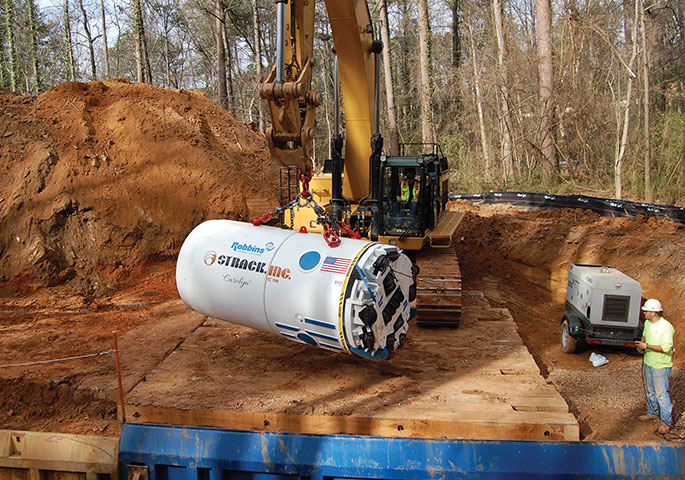May 2017 Vol. 72 No. 5
Features
Georgia’s Mixed Geology Requires Unique Solution: Two-Headed Cutting Machine

Can one machine tackle vastly different types of ground? That’s the problem a Georgia-based contractor faced.
When beginning the installation of a new 54-inch-diameter water main in Cobb County, GA, which included three trenchless crossings through multiple ground conditions, Strack Inc. needed one piece of tunneling equipment that worked for all. The contractor opted for a 72-inch Robbins Motorized Small Boring Unit (SBU-M) to complete the work, which added up to 992 feet in total.
“We were able to utilize the same SBU-M, just changing out the cutterhead, to handle specific site conditions,” explained Keith Mayfield, project manager for Strack.
The success of the three crossings required rigorous logistical planning, a knowledgeable crew and close cooperation by all parties involved.
Geological roller coaster
Phase I of Cobb County’s Southwest Connector 54-inch Water Main will replace an aging and overtaxed water supply system of 20-, 24- and 30-inch pipe nearing the end of its useful life. The new ductile iron pipe will provide adequate water supply to Cobb residents and neighboring customers for decades to come. Installing the water main required crossing a creek, an interstate highway and a busy roadway. The first 220-foot crossing, below Rottenwood Creek, required several core samples to be taken.
The cores revealed the crossing began in solid rock and ended in softer material. The rock quality designation (RQD) of the core samples ranged from 42 to 72 percent, while the recovery ranged from 80 to 100 percent – results that indicated a hard to moderately hard continuous bedrock. Because the rock was also seamed, there were concerns about infiltration of water from the creek bed. Tarp was used to line the creek bed.
The second 492-foot crossing, below I-75, also required core sampling. The cores revealed mixed ground conditions ranging from partially weathered rock, sand, clay and mica, to solid rock. RQD ranged from 36.7 to 78.3 percent, while the recovery ranged from 93.3 to 100 percent – an indication of hard to moderately hard continuous bedrock. The final 280-foot crossing below Powers Ferry Road showed mixed ground conditions that consisted of stiff sandy silt, or firm to medium-dense silty sand, with a layer of partially weathered rock.
Strack elected to use a 72-inch Robbins SBU-M already in inventory for the job – with two cutterheads: hard rock for the Rottenwood Creek crossing and mixed ground for the other two crossings. The SBU-M would be able to excavate crossings of 600 feet or more to accurate line and grade using an articulating shield. The machine would be used with a 48/60-1.5 auger boring machine for forward thrust and an in-shield drive motor for torque. Spoils would be removed from the face via an invert auger, piled in the pit using a mini skid-steer and taken out of the pit using a large excavator.
Crossing excavation
A crew of eight began excavation of the Rottenwood Creek crossing first. A 150,000-pound excavator was used to set the machine into place in the launch pit, where it would begin with a concrete starter block. The shored-up pit, with a concrete foundation and headwall, was 46 feet long by 16 feet wide by 25 feet deep.
“On the first bore under Rottenwood Creek, we were concerned that with the seams in the rock, we would take on a lot of water so we lined the creek bed with a tarp and sandbags. This worked well, along with the head itself being sealed off,” stated Mayfield. “The other two crossings were in a mixed ground condition and the head was able to motor right through.”
If any other issues presented themselves during the bore, a Robbins technician was there to help. “The field service tech was great,” said Mayfield. “He was very hands on, knowledgeable and helpful. One particular problem we had was the head was turning backwards, and he was able to troubleshoot the problem and make corrections on the wiring in the conex/control panel.”
The cutterhead was interchanged between crossings with in-shop modifications, which kept everything clean and allowed use of an overhead shop crane. Depending on the ground condition, the machine went from utilizing a hard rock cutterhead equipped with disc cutters, to a mixed ground cutterhead mounted with tungsten carbide roller cutters and carbide bits.
In solid rock, the machine advanced at approximately 5 feet per hour. In softer material, it advanced up to 15 feet per hour. Ultimately, the machine holed through within line and grade requirements on each crossing, just a few inches off the design line and grade. “These were bores for a water main, so line and grade wasn’t as critical as your gravity bores would be,” added Mayfield.
As the machine excavated, 20-foot lengths of steel casing were added behind, each taking about 2.5 hours to set in and weld together. The SBU-M and its four-man crew made a final hole-through 150 days after the launch of the first crossing.
“The overall performance of the machine was great,” said Mayfield. “It was able to provide us with success on all crossings, from hard rock to mixed ground conditions.”
FOR MORE INFORMATION:
Strack Inc., (770) 969-1591, strackinc.com
Robbins, (440) 248-3303, therobbinscompany.com




Comments